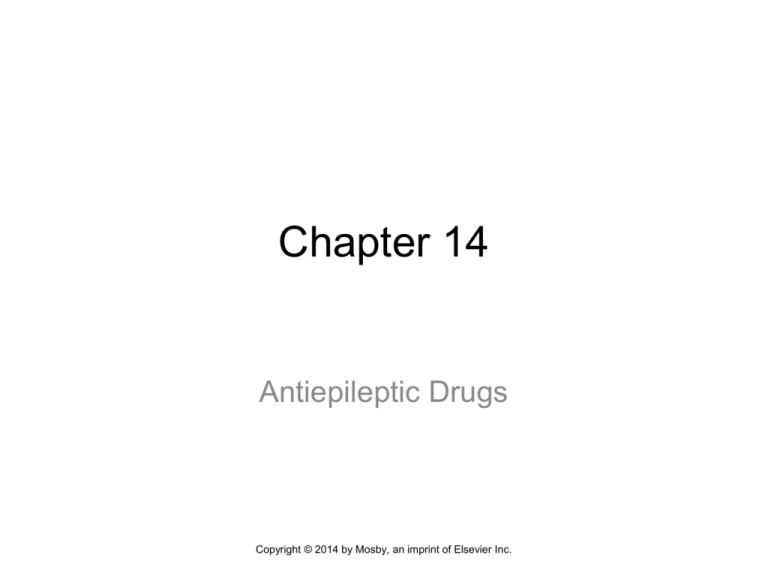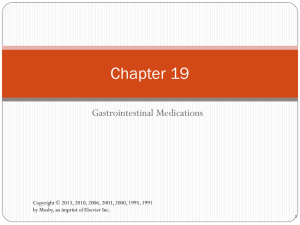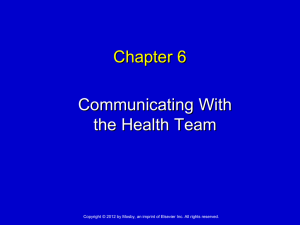Antiepileptic Drugs: Mechanisms, Uses, and Nursing Implications
advertisement

Chapter 14 Antiepileptic Drugs Copyright © 2014 by Mosby, an imprint of Elsevier Inc. Epilepsy Seizure Convulsion Brief episode of abnormal electrical activity in nerve cells of the brain Involuntary spasmodic contractions of any or all voluntary muscles throughout the body, including skeletal, facial, and ocular muscles Epilepsy Chronic, recurrent pattern of seizures Copyright © 2014 by Mosby, an imprint of Elsevier Inc. 2 Epilepsy (cont’d) Primary (idiopathic) Cause cannot be determined Roughly 50% of epilepsy cases Secondary (symptomatic) Distinct cause is identified • Trauma, infection, cerebrovascular disorder Copyright © 2014 by Mosby, an imprint of Elsevier Inc. 3 Classification of Epilepsy Generalized onset seizures Formerly known as grand mal seizures Partial onset seizures Simple (formerly known as petit mal seizures) Complex Secondary generalized tonic-clonic Unclassified seizures Copyright © 2014 by Mosby, an imprint of Elsevier Inc. 4 Antiepileptic Drugs (AEDs) Also known as anticonvulsants Goals of therapy To control or prevent seizures while maintaining a reasonable quality of life To minimize adverse effects and drug-induced toxicity AED therapy is usually lifelong Combination of drugs may be used Copyright © 2014 by Mosby, an imprint of Elsevier Inc. 5 Antiepileptic Drugs (cont’d) Single-drug therapy started before multiple-drug therapy is tried Serum drug concentrations must be measured Therapeutic drug monitoring Patients who are seizure free for 1 to 2 years may be able to discontinue antiepileptic therapy Copyright © 2014 by Mosby, an imprint of Elsevier Inc. 6 Mechanism of Action and Drug Effects Exact mechanism of action is not known Pharmacologic effects: Reduce nerve’s ability to be stimulated Suppress transmission of impulses from one nerve to the next Decrease speed of nerve impulse conduction within a neuron Copyright © 2014 by Mosby, an imprint of Elsevier Inc. 7 Antiepileptic Drugs: Indications Prevention or control of seizure activity Long-term maintenance therapy for chronic, recurring seizures Acute treatment of convulsions and status epilepticus Other uses Copyright © 2014 by Mosby, an imprint of Elsevier Inc. 8 Antiepileptic Drugs: Adverse Effects Numerous adverse effects—vary per drug Adverse effects often necessitate a change in medication Black box warning as of 2008 Suicidal thoughts and behavior Long-term therapy with phenytoin (Dilantin) may cause gingival hyperplasia, acne, hirsutism, and Dilantin facies Copyright © 2014 by Mosby, an imprint of Elsevier Inc. 9 Classroom Response Question A patient in a long-term care facility has a new order for carbamazepine (Tegretol) for seizure management. The nurse monitors for autoinduction, which will result in A. B. C. D. toxic levels of carbamazepine (Tegretol). lower than expected drug levels. gingival hyperplasia. cessation of seizure activity. Copyright © 2014 by Mosby, an imprint of Elsevier Inc. 10 First-Line Antiepileptic Drugs carbamazepine (Tegretol) phenobarbital phenytoin (Dilantin) primidone (Mysoline) valproic acid Copyright © 2014 by Mosby, an imprint of Elsevier Inc. 11 Second-Line Antiepileptic Drugs (Adjunct) ethosuximide (Zarontin) gabapentin (Neurontin) lamotrigine (Lamictal) diazepam (Valium) clonazepam (Klonopin) clorazepate (Tranxene) acetazolamide (Diamox) levetiracetam (Keppra) topiramate (Topamax) zonisamide (Zonegran) tiagabine (Gabitril) pregabalin (Lyrica) Copyright © 2014 by Mosby, an imprint of Elsevier Inc. 12 Classroom Response Question The nurse is assessing the current medication list of a newly admitted patient. The drug gabapentin (Neurontin) is listed, but the patient states that he does not have any problems with seizures. The nurse suspects that the patient A. B. C. D. is unaware of his own disease history. has been taking his wife’s medication by mistake. may be taking this drug for neuropathic pain. is reluctant to admit to having a seizure disorder. Copyright © 2014 by Mosby, an imprint of Elsevier Inc. 13 Nursing Implications Assessment Health history, including current medications Drug allergies Liver function studies, CBC Baseline vital signs Copyright © 2014 by Mosby, an imprint of Elsevier Inc. 14 Classroom Response Question Before a patient is to receive phenytoin (Dilantin), the nurse practitioner orders lab work. Which lab result is of greatest concern? A. B. C. D. High white blood cell count Low serum albumin levels Low platelet levels High hemoglobin levels Copyright © 2014 by Mosby, an imprint of Elsevier Inc. 15 Nursing Implications (cont’d) Oral drugs Take regularly, same time each day Take with meals to reduce GI upset Do not crush, chew, or open extended-release forms If patient is NPO for a procedure, contact prescriber regarding AED dosage Copyright © 2014 by Mosby, an imprint of Elsevier Inc. 16 Classroom Response Question A patient with unstable epilepsy is receiving IV doses of phenytoin (Dilantin). The latest drug level is 12 mcg/mL. Which administration technique will the nurse use? A. B. C. D. Administer the drug by rapid IV push Infuse slowly, not exceeding 50 mg/min Mix the medication with dextrose solution Administer via continuous infusion Copyright © 2014 by Mosby, an imprint of Elsevier Inc. 17 Nursing Implications (cont’d) Intravenous forms Follow manufacturer’s recommendations for IV delivery—usually given slowly Monitor vital signs during administration Avoid extravasation of fluids Use only normal saline with IV phenytoin (Dilantin) Copyright © 2014 by Mosby, an imprint of Elsevier Inc. 18 Nursing Implications (cont’d) Teach patients to keep a journal to monitor: Response to AED Seizure occurrence and descriptions Adverse effects Instruct patients to wear a medical alert tag or ID AEDs should not be discontinued abruptly Follow driving recommendations Copyright © 2014 by Mosby, an imprint of Elsevier Inc. 19 Nursing Implications (cont’d) Teach patients that therapy is long term and possibly lifelong (not a cure) Monitor for therapeutic effects Decreased or absent seizure activity Monitor for adverse effects Mental status changes, mood changes, changes in level of consciousness or sensorium Eye problems, visual disorders Sore throat, fever (blood dyscrasias may occur with hydantoins) Many others Copyright © 2014 by Mosby, an imprint of Elsevier Inc. 20 Classroom Response Question Which information will the nurse provide to the patient who is receiving antiepileptic drug therapy? A. If you feel sleepy when taking the drug, decrease the dose by one half B. Take the drug on an empty stomach C. Call your health care provider if you experience a sore throat or fever D. Patients with epilepsy are not able to hold a job and work, so you should apply for benefits Copyright © 2014 by Mosby, an imprint of Elsevier Inc. 21




